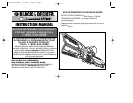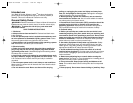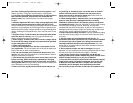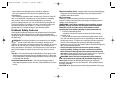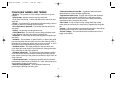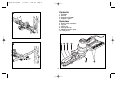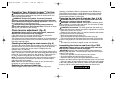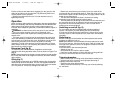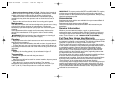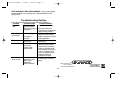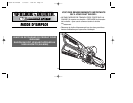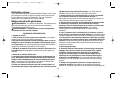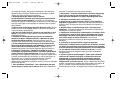
5
- Worn chains and chain guide bars should be replaced.
- Only use replacement bars and chains specified by the
manufacturer.
- This electrically powered saw is classified by CSA as a Class 2C
saw. It is intended for infrequent use by homeowners, cottagers,
and campers, and for such general applications as clearing,
pruning, cutting firewood, etc. It is not intended for prolonged use.
Prolonged periods of operation can cause circulatory problems in
the user's hands due to vibration. For such use, it may be
appropriate to use a saw having an anti-vibration feature.
Kickback Safety Features
Guard against kickback. Kickback is the upward motion of the guide
bar that occurs when the saw chain, at the nose of the guide bar,
contacts an object. Kickback can lead to dangerous loss of control of
the chain saw.
WARNING: The following features are included on your Alligator
Lopper
TM
to help reduce the hazard of kickback; however such
features will not totally eliminate this dangerous reaction. As a chain
saw user do not rely only on safety devices. You must follow all
safety precautions, instructions, and maintenance in this manual to
help avoid kickback and other forces which can result in serious
injury.
Top Jaw - This has been designed specifically to cover the tip of the
chain bar where the danger zone for kickback occurs. In the event
of any kickback the guard also helps prevent the chain coming into
contact with the operator.
Reduced Kickback Guide Bar - This has been designed with a
small radius tip which reduces the size of the kickback zone on the
bar tip.
Reduced Kickback Chain - Designed with a contoured depth gauge
and guard link which deflect kickback force and allows wood to
gradually ride into the cutter.
Electrical safety
This tool is double insulated; therefore no grounding wire is
required. Always check that the power supply corresponds to the
voltage on the rating plate.
WARNING: Some dust created by power sanding, sawing,
grinding, drilling, and other construction activities contains
chemicals known to cause cancer, birth defects or other
reproductive harm. Some examples of these chemicals are:
• lead from lead-based paints,
• crystalline silica from bricks and cement and other masonry
products, and
• arsenic and chromium from chemically-treated lumber. (CCA)
Your risk from these exposures varies, depending on how often you
do this type of work. To reduce your exposure to these chemicals:
work in a well ventilated area, and work with approved safety
equipment, such as those dust masks that are specially designed to
filter out microscopic particles.
• Avoid prolonged contact with dust from power sanding,
sawing, grinding, drilling, and other construction activities.
Wear protective clothing and wash exposed areas with soap
and water. Allowing dust to get into your mouth, eyes, or lay on the
skin may promote absorption of harmful chemicals.
WARNING: Use of this tool can generate and/or disburse
dust, which may cause serious and permanent respiratory or
other injury. Always use NIOSH/OSHA approved respiratory
protection appropriate for the dust exposure. Direct particles away
from face and body.
CAUTION: Wear appropriate personal hearing protection during use.
479970-00 LP1000 9/14/05 1:00 PM Page 5



